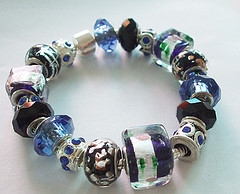
What is a Diamond?
Diamonds are the glamorous stones that decorate the finest jewelry in the world, but just what exactly are diamonds? How are they formed? Where are they found? If you are curious about these questions then read on because I would like to share with you the most important facts about diamonds.
First of all, diamonds are made of carbon. Charcoal and graphite are also composed of carbon, but their chemical structure is different. In diamonds each carbon atom is bonded to four other carbon atoms in a tetrahedral structure, like a pyramid.
Each link or bond is the same length, and the tetrahedral formation is completely regular. It is the structure, strength and regularity of this bonding which makes diamonds very hard, non-volatile and resistant to chemical attack.
Diamonds are one billion to three billion years old. They were formed deep within the Earth’s crust, and come to the surface via volcanoes. Most diamonds are found in Kimberlite, which is a volcanic rock.
Diamonds seem to have been known for about 3,000 years. However, in early times, other hard minerals were often confused with diamonds. The earliest diamonds were found in about the 12th century B.C., in India. India remained the most important, if not the sole, source until 1725, when diamonds were discovered in Brazil.
The Indian and Brazilian deposits had been almost exhausted when, in 1866, the Eureka diamond was discovered in South Africa, followed by the Star of South Africa in 1869. Soon afterwards, the great South African diamond rush had started and till today South Africa remains one of the world’s most important sources of diamonds. However, diamonds have since been discovered throughout the world, including Russia and Australia.
Until the South Africa finds, diamonds were so rare and valuable, that they were only owned by the very wealthy.
Diamond possesses many qualities, which make it an ideal gemstone.
They are extremely hard, and also very tough and hard-wearing and this helps it to take a very high polish. In its pure form the diamond is colorless and has a high refractive index, so has a very high luster. Diamonds possess high dispersion qualities and different light wavelengths are diffracted differently, giving a strong scintillating play of prismatic colors. Despite these generalqualities, 80% of the world’s diamonds are not suitable for jewelry.
Pure diamond, if it existed, is colorless. Most diamonds have a slight color, although the color is almost imperceptible. The commonest color is yellow, which is caused by tiny amounts of nitrogen being present in the crystal structure.
Other colors include gray, light brown or greenish. Diamonds can be almost any color, although strongly colored, attractive specimens are very rare. In addition, colorful diamonds have not been widely promoted by diamond manufacturers because if consumers liked blue, red, green and other colors then they might start buying sapphires, rubies, emeralds and other gemstones instead.
In any case, colored diamonds can be artificially produced or modified. Some fancy colored diamonds are produced by irradiation and heat treatment. Natural, fancy colored diamonds command very high prices, especially if they are the more popular colors. Fancy colored diamonds where the color is artificially produced are no less beautiful, but sell for more normal prices. Occasionally, fancy colored diamonds are available in blue, green, yellow, orange, pink, purple, brown and even black.
The next time you see a beautiful diamond, you can reflect on the one billion year history of this glittering object.
About the Author
Lewis Jewelers is proud to carry the full line of
Pandora Jewelry
. Pandora bracelets, Pandora charms and Pandora beads are only a part of the collection. For more information, Lewis Jewelers, 2000 West Stadium Blvd., Ann Arbor, Michigan, 48103, 877-88-LEWIS or visit the website.
silver bead for bracelet wholesaler Thailand factory manufacturer Bangkok – www.jewelryprincess.com